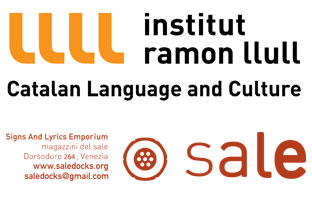Mabel Palacín: 180º
54th International Art Exhibition –
la Biennale di Venezia
Catalonia and Balearic Islands
Magazzino del Sale N.2
Dorsoduro 265, Venice
4 June–30 October 2011
Visiting hours:
From 10am to 18pmProject website:
Venezia.llull.cat
Press Conference
Wednesday, 1st June at 16.30pm
Magazzino del Sale N.2
Dorsoduro 265, Venice
Mabel Palacín began her career in the early nineties in connection with a generation of Catalan artists who continued the conceptual tradition. While their work represented a jump or a break with the return to the painting of the eighties, they were linked to this tradition with approaches that questioned the status of the image and representation, the return to the object and its consideration, and the recovery of neo-conceptual and neo-dada approaches in the international context. Since then, her projects have focused on two issues: the status of images in today’s world (the crisis of the image and its representation) and forms of artistic output. She has thus been concerned with reflecting on the image as universal language: how new systems of production and dissemination (from mobile phones to social networks) have allowed global access to images, and how these have taken a central role that conditions, affects and explains the present-day social, economic and political reality.
180º, the title of the project for la Biennale di Venezia, alludes to the so-called 180º rule in film that establishes the relationship between the position of the camera and that of the viewer. Mabel Palacín’s project refers to this principle to show that it is precisely the relationship between the viewer and the image that has been altered in the contemporary world by multiplication and democratic use. Hence approaches inherent in the modern age, such as the distance between transmitter and receiver, or the medium defining the image, are no longer valid.
The project 180º starts out from a large-scale view of a building in Venice, part of a high-definition photograph. Obtaining this required a production that took into account all the features that appear in it. A video also examines the image, revealing details and proposing various narratives that are written on the screen, about which the image speaks. The central image in 180° is both a moving picture and a still image, causing a lack of differentiation between media. The project also includes another series of videos taken from the wooden roof terraces that are so characteristic of Venice. These videos function as vanishing points. Obtained through various recording media, in high and low quality, they initiate a journey or dialogue between different characters based on the main building featured in the project.
However, 180º does not focus only on the change in the status of the image today; it unfolds in various layers. It proposes a dialogue between history and the contemporary world in choosing the city of Venice or the roof terraces as characteristic features of a city steeped in history. 180º starts out from an urban view of Venice and hence refers to a genre of historical painting that is characteristic of the city, the vedute. Hence architecture, the urban landscape, the city and the collective appear as subjects. And it even includes references to current political events: in recent years the roofs and monuments of Italian cities have been used as spaces for demonstrations.
In 180º, through photographs and videos in which both media overlap, Mabel Palacín reflects the multiplicity of the image, its non-univocal character, and the user’s role in the construction of distinctive narratives. The very title echoes the universal language that has been assumed by the image: it is made up of figures that need no translation. And Venice becomes the subject of the project highlighting a dialogue between history and the contemporary: Venice as a space in which urban views originated, and the urban as a space in contemporary life.
International Press Contact:
Diana Marrone
prundercover@gmail.com
Press Contact:
Gavina Garcia
ggarcia@llull.cat

